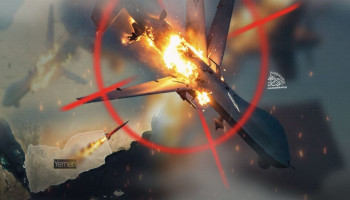The recent incident involving the Greek-flagged tanker Sounion, which was set ablaze by Yemeni armed forces last week, highlights the controversial role the United States plays in manipulating global awareness. Despite the lack of solid evidence to support U.S. claims of an oil spill in the Red Sea, the U.S. continues to cling to this narrative, raising questions about the real motives behind this stance.
It seems that promoting stories surrounding the Sounion extends beyond mere environmental protection, evolving into a tool within a broader political and diplomatic campaign to justify future interventions in the region.
Moreover, this American behavior reflects an attempt to cover up the colossal failure of the operations under the so-called "Guardians of Prosperity" coalition, which has not achieved its declared objectives.
In this context, issues like the alleged oil spill are being used to divert attention from these failures and to rebrand the United States as the steadfast guardian of international security and stability. Therefore, the U.S.'s efforts to distort global awareness regarding the Sounion tanker reveal the complex political and economic ambitions driving its actions in the region.
Undeniable Facts
On the other hand, the Yemeni navy deliberately detonated the tanker using carefully placed explosives designed to ignite the ship's deck and burn the oil inside without causing any damage to the ship's hull or leading to an oil spill. The damage was limited to the tank roofs, confirming that the environmental impact would be negligible compared to other incidents where oil spills into the water.
The key points to consider are the type of explosives used and their application. If the explosives were designed to target only the roofs without affecting the tank sides, the risk of an oil spill into the water would be prevented.
It's a basic fact that when fuel catches fire, the flames rise upward, eliminating any chance of burning other materials or contaminating the surrounding waters.
Tank Design on Oil Ships
Scientific data confirms that oil tanks on ships are designed to withstand high pressures and are equipped with safety systems to prevent spills. Thus, if the explosives were aimed solely at the roofs, the fuel would ignite without spilling into the water, provided the tank sides remain intact.
Explosion Direction
If the explosives were directed upwards, the explosion would result in the fuel burning in the air, ensuring no possibility of oil spilling into the water. This aligns with reports indicating that there was no oil spill from the Sounion despite the multiple fires.
Conclusions
Reports confirm that there has been no oil spill from the Sounion, supporting the theory that the explosions were aimed at the tank roofs.
Sources also state that while fires continue to burn on the ship's deck, they have not led to an oil spill, indicating that the tank sides were strong enough to withstand the pressure from the explosion.
U.S. Obstructs Ship Rescue
Exposing the American deception, the head of the Yemeni delegation, Mohammed Abdul-Salam, announced that European countries had been granted permission to tow the burning Greek tanker, while British media revealed U.S. obstacles hindering the towing operation of the Sounion in the Red Sea.
The British maritime newspaper Lloyd's List reported that U.S. sanctions were blocking the towing of the burning oil tanker Sounion in the Red Sea, noting that "media reports indicated that Sana’a had provided assurances of not attacking the tugs if they obtained the necessary permits."
American Diversion
Ignoring the evidence and scientific facts, the United States, with its vast scientific and technological capabilities, continues to insist on the claim of an oil spill from the Sounion, driven by several political and strategic motives. One of the primary objectives is to reinforce these claims as part of a media campaign aimed at tarnishing the image of the Yemeni navy and increasing international pressure on Sana’a. These efforts coincide with attempts to justify the formation of international coalitions aimed at rallying support for military or political interventions in the region under the pretext of protecting the marine environment.
Recent U.S. communications with Italy highlight its efforts to activate the Barcelona Convention and its protocols, which require contracting states to take joint measures to prevent and combat marine pollution. These agreements include measures to reduce pollution from ships and aircraft, and provide support to developing countries to enhance their capabilities in addressing marine pollution.
These pretexts, claims, and American communications reveal an attempt to cover up the disappointment faced by the U.S. in breaking the rising power from Yemen’s coasts, a power that has become a source of fear for the U.S. administration and a concern for its favored ally, Israel, which remains anxiously awaiting a promised Yemeni response.
Reassuring Israel
Israel, a key U.S. ally in the region, has significant strategic and security interests in the Red Sea and surrounding areas. Any potential threat to maritime navigation or regional stability could directly impact what the U.S. calls Israel's security and economic interests.
In this context, the American claims of an oil spill from the Sounion serve to reassure Israel and could be used as a pretext to strengthen military and political cooperation between the U.S. and Israel, as well as to justify any future interventions in the region. This cooperation could include intelligence sharing, coordination of military operations, and enhancement of naval defenses.
Additionally, Israel is concerned about the growing power in Yemen, particularly regarding its ability to threaten navigation in the Red Sea. This concern drives Israel to support U.S. efforts to increase pressure on Sana’a and reduce its maritime influence.
Therefore, Israel’s role in this context supports U.S. efforts to bolster what it claims is the pursuit of providing security and stability in the region and protecting its strategic interests through close cooperation with the United States.
Eyewitness Accounts
It is noteworthy that the EU's Operation Atalanta in the Red Sea has confirmed multiple times that the Greek tanker Sounion continues to burn.
This supports local sources' claims that the explosions targeted the tank roofs and that the explosives were directed upwards. Consequently, no harm occurs as long as the explosions are directed upward, and only the roofs are destroyed, while the fuel burns upwards without leaking into the water.
The EU mission issued a statement noting that "fires have been burning on the Sounion since August 23."
The statement added, "Multiple fires were detected at several locations on the ship’s main deck."
It also noted that "assets operating in the area confirmed that there was no oil spill and that the ship remains anchored and is not drifting."
The statement concluded that "the European Union, through diplomatic efforts and engagements, plays a critical role in facilitating the rescue of the Sounion."







